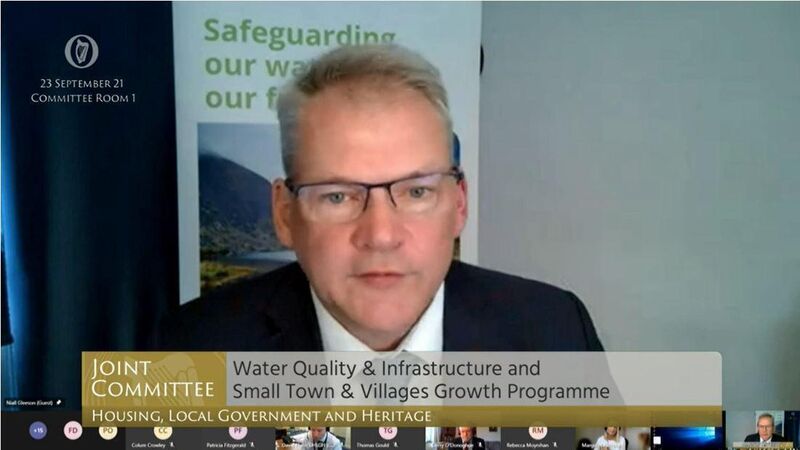Irish Water is in an unhappy place.
Born under a cloud of opprobrium back in 2013, amid accusations of squandered State funds during its establishment and the almighty row over water charges, it was intended to revitalise the country’s crumbling water infrastructure. The utility is neither fish nor fowl; it’s run on a commercial basis, as a subsidiary of Ervia, but, since it can’t collect water charges from households, it’s publicly funded.
Despite the public funding — to the tune of €1.4bn in 2021 — the utility is exempt from audit by the Comptroller and Auditor General, the State’s accountant, with private consultants Deloitte instead doing the honours since 2014. More recently, some of the strains of that particular public/private contradiction have begun to show.
Last week it emerged that 52 people were hospitalised after consuming an unsafe supply laced with bacteria like e.coli, because of two major breaches of water contamination protocol in plants in Dublin and Wexford. The incidents are likely to lead to legal suits for compensation on the part of those affected.
The hospitalisations in Wexford — which saw residents of Gorey taken violently ill with vomiting, passing of blood, and cramping — resulted from both a power outage and a chlorine pump failure at the local treatment plant allowing non-disinfected water into the local supply. The issue was compounded by it going unreported for five days, while the HSE and Environmental Protection Authority (EPA) only learned of it a further two days later.
In the capital meanwhile, the Ballymore Eustace plant — which serves about 877,000 consumers in the greater Dublin area — also saw unsafe water enter the public drinking water supply.
It’s not the first such occasion. In 2019, 600,000 people in Kildare were placed on boil water notice on foot of water contamination concerns at a plant in Leixlip not being reported in time. These latest breaches have given rise to an urgent audit of Ireland’s roughly 1,000 wastewater treatment plants, beginning with the largest 20.
Ireland's rickety water infrastructure
Contamination isn’t the only headache the utility is dealing with. During the summer, amid a weeks-long heatwave, the country’s water supplies again teetered on the brink of crisis amid a surge in demand with a number of major bursts brought about by hardening ground serving to compound matters.
The chief problem is that Ireland’s water infrastructure is old, complex, and fundamentally not fit for purpose. Every day the country loses roughly 40% of its treated water supply before it even reaches our taps (Irish Water says it hopes to reduce that figure to something like 38% by the end of this year).
Meanwhile, over 4,200 people around the country currently live with water supplies covered by either boil water or do not consume notices (Irish Water notes the number of supplies so affected has reduced from 229 in 2008 to 53 in September 2021). Separately, the levels of raw sewage being pumped into rivers and seas has reduced by 60% since Irish Water’s establishment, the utility says.

To get an impression, however, of just how rickety Ireland’s water supply currently is, you need only cast your mind back to the summer of 2017 when a 50-year-old main, which had become warped, burst at the Staleen water treatment plant in Drogheda, Co. Louth, with water supply switched off for 90,000 local residents for a week.
Some of the problems with that repair included the main in question being four metres underground on private land, and the fact sourcing a replacement part for such an outdated piece of equipment proved quite troublesome. In a report following the incident, Irish Water admitted that such outages could be expected to be a “common occurrence for years to come”, and said that €18 billion in investment would be required to bring the country’s supply infrastructure up to scratch.
To an extent the utility’s hands are tied given the model it was created to follow — one involving water charges paid by the public to allow for increased capital expenditure — never came to pass.
Given the nationwide movement that anti-water charges sentiment gave rise to in 2014, it’s difficult to see how that particular hot potato could be pulled back onto the political agenda.
The connection with local authorities
In terms of its current travails however, Irish Water has taken aim firmly at the status quo which sees Ireland’s local authorities contracted with the utility to deliver water services. From adversity comes opportunity.
On the events in Gorey, the utility pointed the figure firmly at Wexford County Council.
“We should have been informed by Wexford County Council as soon as the incident happened. We are trying to understand exactly what happened, why there was a failure in communication,” Niall Gleeson, Irish Water’s chief executive, said earlier this week.
At present the utility is involved in a lengthy battle with the local authorities to have about 3,500 council staff to be taken directly under the wing of Irish Water after the Government announced in February that the current system of service level agreements (SLAs) would be phased out by the end of 2022.

The same move would see Irish Water split from its current parent Ervia (which also operates Bord Gais) and become an independent entity.
The problem is that the workers from the 31 local authorities don’t want to work directly for the utility, with negotiations at the Workplace Relations Commission ending inconclusively during the summer. Those discussions are due to return to the WRC next month.
On Thursday of last week, Mr Gleeson upped the ante considerably, telling the Oireachtas housing committee that its current arrangement of working alongside the councils “is no longer fit for purpose” and is in “urgent need of change”.
Addressing the committee, Mr Gleeson said “the issues that have arisen at the water treatment plants in Dublin and Wexford clearly show the limitation of the present ways of working and emphasise the urgent need for change”.
“While equipment failure and human error can occur, late reporting of issues relating to the process failures at the plants, left us unable to react and compromised water quality.”
“Irish Water has legal responsibility but no direct control over water treatment plants around the country,” he said.
“Drinking water incidents can, and do, occur and it is essential that we put the best possible structures and systems in place to reduce the frequency of such incidents, and to deal with them effectively when they do.” It is “critical”, he said, that water treatment move to the remit of a single public utility as a matter of urgency”.
That may be easier said than done.
Local authority workers' concerns
Adrian Kane, Siptu’s divisional organiser with responsibility for the WRC talks, is clear that the 3,000 local authority workers he represents will happily go on strike if they feel they are being forced into employment with Irish Water.
“We are engaging, but as we see it there are four strands to this process,” he said, they being the WRC negotiations, certainty regarding a referendum on the future of water ownership (mooted for 2020 prior to the last election by then housing minister Eoghan Murphy), the future ownership of Irish Water itself, and the future of the local authorities, which have dropped in employee headcount by 20% since 2008.
Mr Kane described that final point as being emblematic of a “pincer attack” by the Government on the traditional system of local governance via “privatisation and outsourcing”, as seen in the movement of domestic waste and driving licence services to private operators.
“We’re not agreeing to anything unless a blueprint for regeneration of local government is outlined,” he said.
As regards the transfer of workers first outlined in Minister for Housing Darragh O’Brien’s policy paper on the topic in February (which suggested the transfer would be completed by July), Mr Kane said “the minister talks about the need for Irish Water to have control of the workforce, not for the need to transfer workers to Irish Water”.

A neat distinction?
“It’s within that space that we are attending at the WRC,” he said.
Meanwhile, in terms of the suggestion that the Gorey incident transpired as a result of a disconnect between local authority water workers and the utility itself, Mr Kane says “I don’t believe the two are related”.
“It appears to be a technical problem related to an alarm system that could have happened no matter what the makeup of the body delivering water,” he said, adding to suggest otherwise is “not helpful”.
“It’s a bit of a jump to go from this specific incident to saying that the only way to resolve this is the transfer of staff,” he said.
As regards what happens next for Irish Water, at present that would seem to hinge on whatever form the next crisis eventually takes. And given there simply isn’t enough money to go around to solve Ireland’s water ills in one swoop, such a crisis is surely only a matter of time.

Subscribe to access all of the Irish Examiner.
Try unlimited access from only €1.50 a week
Already a subscriber? Sign in
CONNECT WITH US TODAY
Be the first to know the latest news and updates











